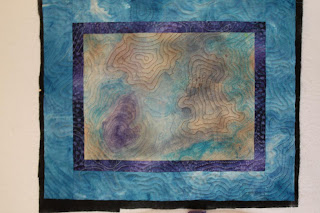Several thermofax screens arrived this week, some pre-made and others from my own photos. I tested one, and when I washed it out, it came adrift from the frame, which is a bit disappointing. When I get enthused again, I will re-attach it with duct tape this time. One of the ones from my Japanese stencils is not perfect - partly my fault for not double checking the photo, which I had converted to b and w, but there were still some pixels of the wrong colour in the wrong place. I think I have found a tool in Photoshop to remove all the white areas, so at least they will be blank. Then I had to adjust the blacks, as there were some charcoal grey pixels. All imperfections show up on the screen. This afternoon I tested all the others. The other Japanese stencil one is fine, and one of the smaller purchased screens also came partly adrift. I am not sure I will be a fan of thermofaxes. To be honest the freezer paper stencils on the normal screens worked the best.
Having postponed the poppy project until I can get to London to look for my print, I tried to finish the map of the islands idea. This started as a piece of calico that I blobbed all my blue paints on, to see what they looked like, plus a purplish blue. After that I spritzed it with Mountain Mist or whatever it's called - the walnut ink one. I added a couple of borders, and left it till I got back from Wellington. I then decided to trial quilting all over the borders as well as the centre, with the same kind of lines. I wanted to get away from having separate quilting stitches for each part of the quilt. I used some 40wt variegated threads, and some metallic, and one 30 wt. Then round the three 'islands' I did some thicker thread using the bobbin. So far so good.
Having postponed the poppy project until I can get to London to look for my print, I tried to finish the map of the islands idea. This started as a piece of calico that I blobbed all my blue paints on, to see what they looked like, plus a purplish blue. After that I spritzed it with Mountain Mist or whatever it's called - the walnut ink one. I added a couple of borders, and left it till I got back from Wellington. I then decided to trial quilting all over the borders as well as the centre, with the same kind of lines. I wanted to get away from having separate quilting stitches for each part of the quilt. I used some 40wt variegated threads, and some metallic, and one 30 wt. Then round the three 'islands' I did some thicker thread using the bobbin. So far so good.

I obviously needed to make the island shapes more distinct, as from a distance you couldn't make them out. I used metallic oil pastels round the edge. Then I added a mixture of shiva paintsticks inside those lines. I was playing with a treasure map idea by this time. I plotted the voyage of an imaginary ship. Added a funicular to the top of one mountain, and a couple of footpaths on the other two islands, using the stitch where you have invisible in the top and coloured in the bobbin and it makes a dashed line. Had to have the top tension on 9 to make it work!
I played with beads in the centre, but again, from 3 metres you couldn't see them. I tried bigger and bolder beads, but didn't like the effect.

 Since it would involve stitching at least 200 seedbeads, and I wasn't going to like the finished thing, I put all the beads back in their jars! My latest idea is to print some mappish names like Smugglers Cove onto transfer paper and label the map. Much scratching of head later, I think I am ready to put a back on it and forget the whole thing, as just a learning exercise. There are things I really like about it, and the whole map plus contour lines idea is one I think I will play with some more.
Since it would involve stitching at least 200 seedbeads, and I wasn't going to like the finished thing, I put all the beads back in their jars! My latest idea is to print some mappish names like Smugglers Cove onto transfer paper and label the map. Much scratching of head later, I think I am ready to put a back on it and forget the whole thing, as just a learning exercise. There are things I really like about it, and the whole map plus contour lines idea is one I think I will play with some more.






